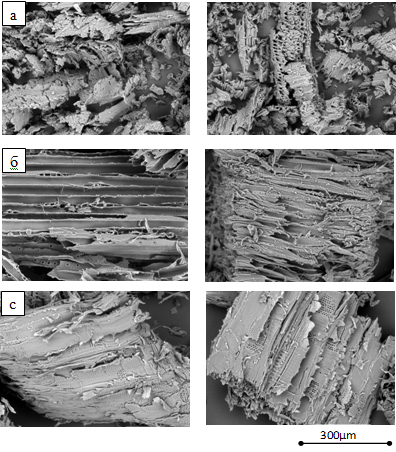THE EFFECT OF LONG EXPOSURE OF BIRCH, ASPEN AND PINE SAWDUST IN WATER ON YIELD AND SPECIF-IC SURFACE AREA OF THE CARBON PRODUCT
Abstract
The article presented researches concerning the effect of prolonged exposure in water of wood of different species - birch, aspen and pine, on the formation of carbon materials structure during carbonization. The possibility of using wood waste of different species, subject to long exposure in water, to obtain more porous carbon materials than using original wood is shown.
It was established that the aging of different species in water stimulates the disclosure of the porous structure of the carbon product. This particularly applies to the carbon product of pine wood, the specific surface area which increases from 10 to 455 m2 g-1. It was shown that the yield of the carbon product, increases by 15–25 wt.% using wood prolonged exposure in water.
Using XRD and electron microscopy, features of the structural transformation of birch, aspen and pine wood subjected to water treatment were revealed. Prolonged exposure of different wood species in the water affects the degree of crystallinity of the cellulose fiber in wood. The crystalline component of pine is exposed to the greatest destruction under the action of water.
It was noted that after water treatment of wood, the part of the amorphous component in the carbon product increases, regardless of the type of wood used.
Downloads
Metrics
References
Lionetto F., Del Sole R., Cannoletta D.,Vasapollo G., Maffezzoli A. Materials, 2012, vol. 5, pp. 1910–1922. DOI: 10.3390/ma5101910.
Cogulet A., Blanchet P., Landry V. BioRes, 2018, vol. 13, no. 1, pp. 2116–2138, DOI: 10.15376/biores.13.1.Cogulet.
Agresti G., Bonifazi G., Calienno L., Capobianco G., Monaco A.L., Pelosi C., Picchio R., Serranti S. J. Spectroscopy, 2013, pp. 1–13. DOI: 10.1155/2013/380536.
Anderson E.L., Pawlak Z., Owen N.L., Feist W.C. Applied Spectroscopy, 1991, vol. 45, pp. 641–647.
Marsh H., Rodriguez-Reinoso F. Activated Carbon, Elsevier Ltd., 2006, 536 p.
Danish M., Ahmad T. Renewable and Sustainable Energy Reviews, 2018, vol. 87, pp. 1−21. DOI: 10.1016/j.rser.2018.02.003.
Kumar R.D., Kannan G.K., Kadirvelu K.J. J. Bioremediat&Biodegrad., 2017, vol. 8, no. 6, pp. 1−11. DOI: 10.4172/2155-6199.1000415.
Tsyganova S.I., Romanchenko A.S., Bondarenko G.N., FetisovaO.Yu. Russ. J. Appl. Chem., 2018, vol. 91, no. 2, pp. 330−336. DOI: 10.1134/S1070427218020258.
Kuznetsov B.N., Chesnokov N.V. Khimiya v interesakh ustoychivogo razvitiya, 2018, vol. 3, pp. 305−316. DOI: 10.15372/KhUR20180306. (in Russ.).
Engelund E.T., Thygesen L.G., Svensso S., Hill C.A.S. Wood Sci. Technol., 2013, vol. 47, pp. 141–161. DOI: 10.1007/s00226-012-0514-7.
Berezin A.S., Tuzhikov O.I. Izv. Volgogr. gos. tekh. univer-ta, 2010, vol. 2, no. 62, pp. 5–24. (in Russ.).
Munoz-Gonzalez Yu., Arriagada-Acuna R., Soto-Garrido G., Garcıa-Lovera R. J. Chem Technol Biotechnol., 2009, vol. 84, pp. 39–47. DOI: 10.1002/jctb.2001.
Nakagawa Y., Molina-Sabio M., Rodríguez-Reinoso F. Microporous and Mesoporous Materials, 2007, vol. 103, pp. 29–34. DOI: 10.1016/j.micromeso.2007.01.029.
Moreno-Castilla C., Carrasco-Marin F., Lopez-Ramon M.V., Alvarez-Merino M.A. Carbon, 2001, vol. 39, no. 9, pp. 1415–1420. DOI: 10.1016/S0008-6223(00)00268-2.
Yue Z., Mangun C.L., Economy J. Carbon, 2002, vol. 40, no. 8, pp. 1181–1191. DOI: 10.1016/S0008-6223(01)00268-8.
Isahak W.N.R.W., Hisham M.W.M., Yarmo M.A. J. Chemistry, 2013, pp. 1–6. DOI: 10.1155/2013/620346.
Doczekalska B., Bartkowiak M., Orszulak G., Katolik Z. Forestry and Wood Technology, 2015, vol. 92, pp. 88–91.
Kuznetsov B.N., Chesnokov N.V., Tsyganova S.I., Mikova N.M., Ivanov I.P., Ivanchenko N.M. Solid Fuel Chemistry, 2016, vol. 50, no. 1, pp. 23–30. DOI: 10.3103/S0361521916010067.
Tsyganova S.I., Korol’kova I.V., Fetisova O.Yu, Bondarenko G.N., Kargin V.F. Russ. J. Appl. Chem., 2014, vol. 87, no. 3, pp. 360−364. DOI: 10.1134/S1070427214030197.
Tsyganova S., Mazurova E., Bondarenko G., Chesnokov N. Wood Science and Technology, 2016, vol. 50, pp. 963–972. DOI: 10.1007/s00226-016-0831-3.
Manoj B., Kunjomana A.G. Int. J. Electrochem. Sci., 2012, vol. 7, pp. 3127–3134.
Terinte N., Ibbett R., Schuster K.C. Lenzinger Berichte, 2011, vol. 89, pp. 118–131.
Vrublevskaya V.I., Matusevich V.O., Kuznetsova V.V. Lesn. zhurn., 2017, no. 3, pp. 152–163. DOI: 10.17238/issn0536-1036.2017.3.152. (in Russ.).
Kolosovskaya Ye.A., Loskutov S.R., Chudinov B.S. Fizicheskiye osnovy vzaimodeystviya drevesiny s vodoy: mono-grafiya. [The physical basis of the interaction of wood with water: a monograph.]. Novosibirsk, 1989. 216 p. (in Russ.).
Kotlyarova I.A., Stepina I.V. Vestnik Kazanskogo tekhnologicheskogo universiteta, 2018, no. 6, pp. 87–92. (in Russ.).
Khazraji A.C., Robert S. J. Nanomaterials, 2013, vol. 2013, pp. 1–10. DOI: 10.1155/2013/745979.

Copyright (c) 2019 Khimiia rastitel'nogo syr'ia (Chemistry of plant raw material)

This work is licensed under a Creative Commons Attribution 4.0 International License.

This work is licensed under a Creative Commons Attribution 4.0 International License.
The authors, which are published in this journal, agree to the following conditions:
1. Authors retain the copyright to the work and transfer to the journal the right of the first publication along with the work, at the same time licensing it under the terms of the Creative Commons Attribution License, which allows others to distribute this work with the obligatory indication of the authorship of this work and a link to the original publication in this journal .
2. The authors retain the right to enter into separate, additional contractual agreements for the non-exclusive distribution of the version of the work published by this journal (for example, to place it in the university depository or to publish it in a book), with reference to the original publication in this journal.
3. Authors are allowed to post their work on the Internet (for example, in a university repository or on their personal website) before and during the review process of this journal, as this may lead to a productive discussion, as well as more links to this published work.











